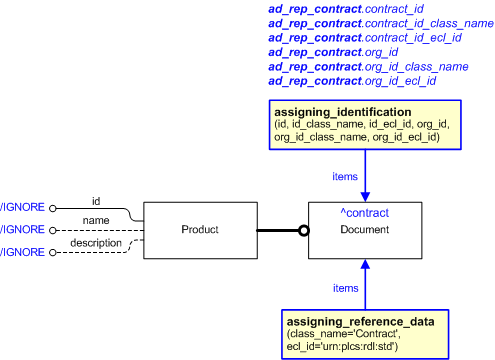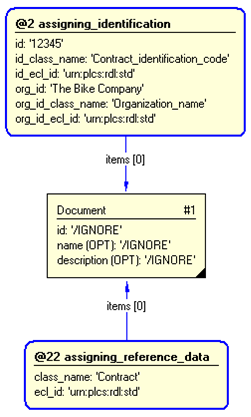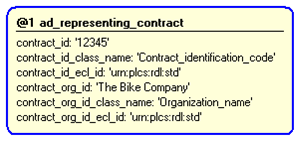Template:— ad_representing_contract (ad_rep_contract)
Context:— Aerospace_and_Defense |
Date: 2011/04/20 13:01:42
Revision: 1.2
|
This section specifies the template ad_representing_contract.
NOTE
The template has been defined in the context of
Aerospace_and_Defense.
Refer to the business context for details of related templates.
NOTE
An explanation of a template and the associated instantiation path is
provided in the
Template overview
section.
This template describes how to represent a contract.
NOTE
This template uses
Document
instead of
Contract
to represent contract, because there is a need to relate different contracts to each other, and there is no such construct
in AP239 ed1 ARM for
Contract .
The EXPRESS-G diagram in
Figure
1
shows the templates and EXPRESS entities that are required
to represent the template
"ad_representing_contract".
The text highlighted in blue shows the template parameters.
Figure 1 — An EXPRESS-G representation of the Information model for ad_representing_contract
The graphic for the template to be used in other EXPRESS-G diagrams
is shown in Figure
2
below.
Figure 2 — The graphical representation of the ad_representing_contract template
The following input parameters are defined for this template:
The identifier of the contract.
The name of the class being used to classify the
contract identifier (@contract_id).
This provides the role or reason for the identification.
The following classes and their sub-classes can be used:
The identifier of the
External_class_library
storing the definition of the class referenced by the parameter @contract_id_class_name.
The name or identifier of the
Organization that owns the contract identifier (@contract_id).
The name of the class being used to classify the identification
of the organization (@contract_org_id).
The following classes and their sub-classes can be used:
The following reference parameters are defined for this template:
Allow the
Document
entity instantiated in this path to be referenced when this template is used.
Note: The
Document
entity can be referenced in a template path by:
%^target = $ad_representing_contract.contract%
where
target
is the parameter to which the
Document
is bound.
The following parameter combinations specify a uniqueness constraint:
Unique constraint: Unique contract
The instantiation path shown below specifies the entities that are to be
instantiated by the template.
A description of templates and the syntax for the instantiation path is
provided in the
Templates Help/Information section.
Document-- Mark the Document (representing Contract) entity as -- referable when this template is used by binding it to the reference -- parameter contract %^contract =
Document%
Document.id = '/IGNORE'
Document.name = '/IGNORE'
Document.description = '/IGNORE'
-- assign the identification to the Contract /
assigning_identification(
items=^contract,
id=@contract_id,
id_class_name=@contract_id_class_name,
id_ecl_id=@contract_id_ecl_id,
org_id=@contract_org_id,
org_id_class_name=@contract_org_id_class_name,
org_id_ecl_id=@contract_org_id_ecl_id)/
-- Classifiy the Document as being a Contract /
assigning_reference_data(
items=^contract,
class_name='Contract',
ecl_id='urn:plcs:rdl:std')/
The following entities are instantiated with attributes as specified:
The instance diagram in Figure
3
shows an example of the EXPRESS entities and templates that are instantiated by the template:
/ad_representing_contract(contract_id='12345', contract_id_class_name='Contract_identification_code', contract_id_ecl_id='urn:plcs:rdl:std', contract_org_id='The Bike Company', contract_org_id_class_name='Organization_name', contract_org_id_ecl_id='urn:plcs:rdl:std')/
(an illustration of the consolidated ad_representing_contract template is shown in
Figure
4 below.)
Figure 3 — Entities instantiated by ad_representing_contract template
The instance model in STEP ASCII exchange file format (ISO 10303 Part
21 syntax) is:
#1 = DOCUMENT('/IGNORE','/IGNORE','/IGNORE');
#3 = IDENTIFICATION_ASSIGNMENT('12345','/IGNORE','/IGNORE',(#1));
#5 = CLASSIFICATION_ASSIGNMENT(#6,(#3),'/IGNORE');
#6 = EXTERNAL_CLASS('/NULL','Contract_identification_code','/IGNORE',#7);
#7 = EXTERNAL_CLASS_LIBRARY('urn:plcs:rdl:std','/IGNORE');
#10 = ORGANIZATION('/IGNORE','/IGNORE');
#12 = IDENTIFICATION_ASSIGNMENT('The Bike Company','/IGNORE','/IGNORE',(#10));
#14 = CLASSIFICATION_ASSIGNMENT(#15,(#12),'/IGNORE');
#15 = EXTERNAL_CLASS('/NULL','Organization_name','/IGNORE',#7);
#17 = ORGANIZATION_OR_PERSON_IN_ORGANIZATION_ASSIGNMENT(#10,'/IGNORE',(#3));
#19 = CLASSIFICATION_ASSIGNMENT(#20,(#17),'/IGNORE');
#20 = EXTERNAL_CLASS('/NULL','Owner_of','/IGNORE',#7);
#23 = CLASSIFICATION_ASSIGNMENT(#24,(#1),'/IGNORE');
#24 = EXTERNAL_CLASS('/NULL','Contract','/IGNORE',#7);
The instance diagram in
Figure
4
shows the graphic symbol for the template that is to be
used in other instance diagrams. The example template is:
/ad_representing_contract(contract_id='12345', contract_id_class_name='Contract_identification_code', contract_id_ecl_id='urn:plcs:rdl:std', contract_org_id='The Bike Company', contract_org_id_class_name='Organization_name', contract_org_id_ecl_id='urn:plcs:rdl:std')/
Figure 4 — Instantiation of ad_representing_contract template
Characterizations
No common characterizations of the template
ad_representing_contract
have been identified. However, the ISO 10303-239 EXPRESS model
may enable other assignments to the entities instantiated by the template.




